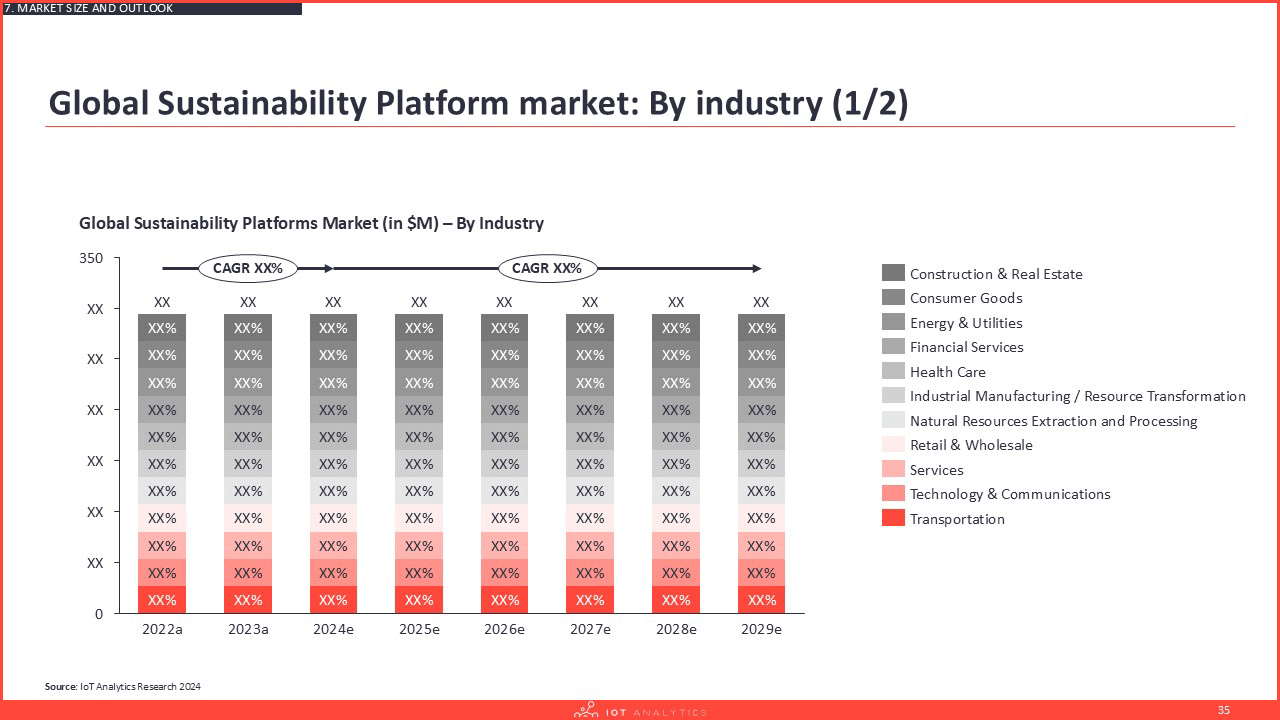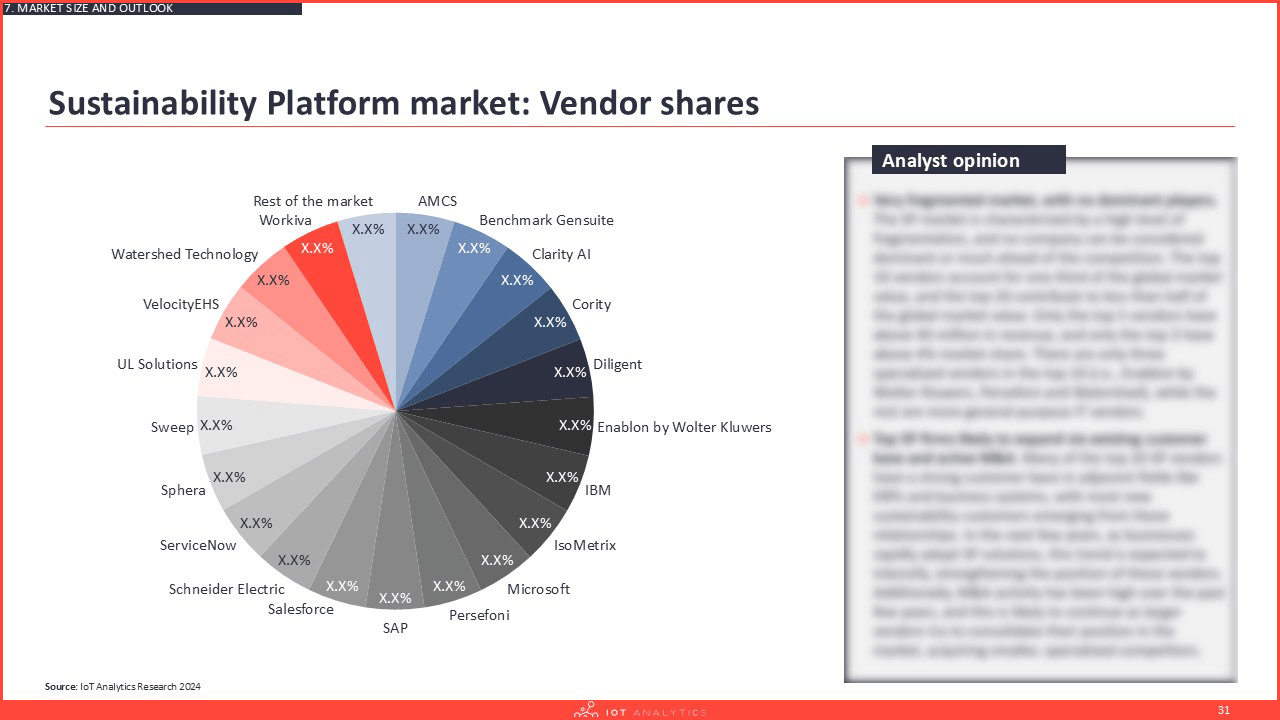Sustainability Platforms Market Report 2025–2029
(see all)
Questions answered
- What are sustainability platforms (i.e., a definition)?
- What are the key features and capabilities of sustainability platforms, both for ESG reporting and for carbon management?
- Who are the leading vendors of sustainability platforms, and how much market share do they have?
- How large is the sustainability platforms market, and how does it split into segments (i.e., by regions or industries)?
- What are some insightful case studies of companies implementing sustainability platforms?
- How does ESG reporting work?
- What are some of the sustainability targets of governments and selected corporations?
- What is sustainability, and what are its various aspects?
- What are the key drivers and trends in the market?
- What are the key challenges to sustainability management platform adoption?
Table of Contents
Sustainability Platforms Market Report 2025-2029 (PDF)
- Executive Summary
- Introduction to sustainability
- Introduction to sustainability: Chapter overview and key takeaways
- Starting point: Becoming sustainable is a top challenge for humanity
- Both public and corporate awareness of “sustainability” and “climate” have jumped in recent years
- Defining 1) sustainability and 2) sustainable development
- The 3 core dimensions of sustainability: The classic sustainability model
- The “stronger” sustainability model puts the environment first
- Key milestones in the evolution of global sustainable development efforts
- There are 6 core aspects of environmental sustainability
- 1. Greenhouse gases: Overview
- 1. Greenhouse gases: What they are
- 1. Greenhouse gases: The nine main types of gases
- 1. Greenhouse gases: Main contributors to GHG emissions
- 1. Greenhouse gases: Emissions by sector
- 1. Greenhouse gases: Fossil fuel company emissions
- 1. Greenhouse gases: The Greenhouse effect
- 1. Greenhouse gases: The effect on climate change
- 2. Policy: The UN Sustainable Development Goals
- 2. Policy: The UN Sustainable Development – goals
- 2. Policy: The UN Sustainable Development – current progress
- 2. Policy: The Paris Agreement – overview
- 2. Policy: The Paris Agreement – current status
- 3. Circular economy: Overview
- 3. Circular economy: Key benefits
- 3. Circular economy: Key challenges
- 3. Circular economy: The role of technology
- 3. Circular economy: Daisy helps Apple battle e-waste
- 3. Circular economy: Life cycle assessment
- 4. Deforestation
- 5. Energy use
- 6. Pollution
- How to become more sustainable: Key analyst viewpoints
- Carbon footprint and management
- Carbon footprint and management: Chapter overview and key takeaways
- What is a carbon footprint?
- The difference between Carbon Neutral and Net Zero
- Three GHG emission scopes for carbon footprint calculations
- Three main ways for companies to reduce their carbon footprint
- Carbon pricing
- Snapshot: Overview of carbon pricing initiatives around the world
- Practical examples of ETS and carbon taxes
- Snapshot: Current ETS and Carbon Taxes pricing trends
- Ten other common sustainable development terms
- Corporate and governmental carbon footprint targets
- Corporate and governmental carbon footprint targets: Chapter overview and key takeaways
- Snapshot: Sustainability targets by major governments
- Snapshot: Sustainability targets by major cities
- Snapshot: Sustainability targets by major corporations
- Example 1: Microsoft’s commitment to sustainability
- Example 1: Microsoft’s mission to become carbon negative by 2030
- Example 2: Apple’s commitment to sustainability
- Example 2: Apple 2030—Apple’s journey to carbon neutrality by 2030
- Example 3: Siemens’ commitment to sustainability
- ESG reporting: Standards, frameworks, KPIs
- ESG reporting – Standards, frameworks, & KPIs: Chapter overview and key takeaways
- Environment, social, and governance reporting and its three dimensions
- The role of ESG reporting
- The difference between ESG and sustainability
- ESG data verification and assurance
- Best practices for ESG reporting
- Understanding ESG standards and frameworks
- There are currently 4 major ESG standards organizations
- These are the four most commonly used ESG frameworks
- The Science Based Targets initiative (SBTi)
- ESG regulations
- ESG regulations: Regional overview
- Deep Dive: Two key ESG reporting regulations in EU and US
- The evolution of ESG reporting highlights the need for global standards
- ESG KPIs: Definition and role
- Overview of common ESG metrics
- Environmental metrics: Description and common KPIs
- Social metrics: Description and common KPIs
- Governance metrics: Description and common KPIs
- Example of standardized ESG metrics #1 : Stakeholder capitalism metrics
- Example of standardized ESG metrics #2: Advanced manufacturing-specific
- Example of standardized ESG metrics #3: Mobile industry-specific
- Example of standardized ESG metrics #4: Manufacturing industry-specific
- Sustainability platforms definition
- Sustainability Platforms definitions & segmentation: Chapter overview and key takeaways
- What are Sustainability Platforms?
- Eight key features of Sustainability Platforms
- Three main categories of sustainability management solutions
- Carbon management platforms
- ESG management and reporting platforms
- Supply chain sustainability platforms
- Eight key benefits of Sustainability Platforms
- Three main pricing models
- Market size and outlook
- Introduction: Chapter overview and key takeaways
- Focus area of this market sizing
- Global Sustainability Platforms Market 2022–2029
- Sustainability Platform market: Vendor shares 2023
- Global Sustainability Platform market: By region
- Global Sustainability Platform market: North America
- Global Sustainability Platform market: Europe
- Global Sustainability Platform market: Asia-Pacific
- Global Sustainability Platform market: Latin America
- Global Sustainability Platform market: Middle East & Africa
- Global Sustainability Platform market: Russia & CIS
- Global Sustainability Platform market: Largest countries
- Global Sustainability Platform market: By industry
- Global Sustainability Platform market: By customer size
- Global Sustainability Platform market: By software type
- Competitive landscape
- Introduction: Chapter overview and key takeaways
- Vendor landscape: By solution focus
- Vendor landscape: By company focus
- Vendor landscape: By company location
- Vendor landscape: By company size
- Noticeable acquisitions of SP companies in the past 3 years
- Vendor landscape: Start-ups
- Most funded SP start-ups
- Company Profiles: Overview
- Vendor profile: Microsoft
- Vendor Profile: SAP
- Vendor Profile: Salesforce
- Vendor Profile: IBM
- Vendor Profile: Sphera
- Vendor Profile: Persefoni
- Vendor Profile: Wolters Kluwer
- Vendor Profile: Workiva
- Vendor Profile: Watershed
- Vendor Profile: Sweep
- Vendor Profile: ServiceNow
- Vendor Profile: Cority
- Vendor Profile: Schneider Electric
- Vendor Profile: Siemens
- Drivers, challenges and trends
- Introduction: Chapter overview and key takeaways
- Drivers: Overview
- Drivers
- Challenges: Overview
- Challenges
- Trends and developments: Overview
- Trends and developments
- Methodology
- About IoT Analytics
Companies mentioned
A selection of companies mentioned in the report.
Apple
Cority
IBM
Microsoft
Persefoni
SAP
Salesforce
Schneider Electric
ServiceNow
Siemens
Sphera
Sweep
Watershed
Wolters Kluwer
Workiva
About the report
The Sustainability Platforms Market Report 2025–2029 is part of IoT Analytics’ ongoing coverage of emerging technology topics and vertical applications. The information presented in this report is based on the results of multiple surveys, secondary research as well as qualitative research, i.e., interviews with industry experts from vendors and end users. The document includes definitions for sustainability platforms, market projections, adoption drivers, competitive landscape, key trends and developments, and case studies.
The main purpose of this document is to help our readers understand the current sustainability platform landscape by defining, sizing, and analyzing the market.
About the market
The sustainability platform market is still at an early stage of development but growing rapidly. Most adopters are still at the pilot stage and/or with small-scale implementations. It is highly fragmented with eight main vendor types. Vendors are categorized into 8 segments:
- Carbon footprint
- ESG & sustainability
- EHS
- Energy
- GRC
- IT/cloud
- Financial
- Consulting.
Key market drivers, challenges, and trends
IoT Analytics identified 5 drivers and 7 challenges highlighted in the report.
What are sustainability platforms?
Definition
Sustainability Platforms are software tools designed to help organizations understand, manage, and improve their sustainability performance. Sustainability Platforms streamline the collection, aggregation, analysis, and reporting of sustainability-related data across various ESG dimensions and provide a holistic view of an organization’s sustainability performance.
Categorization
- Carbon management
- ESG reporting
- Supply chain
Key features
Three of the most important features of Sustainability Platforms are:
- Advanced analytics: These platforms utilize powerful analytics to offer insights into key sustainability metrics, trends, and areas needing improvement, supporting data-driven decision-making.
- Reporting functionalities: Using automated tools can streamline compliance with ESG standards and simplify both internal and external reporting processes.
- Collaboration tools: These tools facilitate communication and engagement among stakeholders through feedback systems, shared dashboards, and integrated workflows.
Key benefits
Three of the most valuable benefits of Sustainability Platforms are:
- Easier regulatory compliance: Automating ESG data management and reporting ensures organizations stay aligned with evolving regulatory requirements.
- Improved decision-making: Data-driven insights enable organizations to identify risks and opportunities, driving strategies that optimize resource use and reduce costs.
- Transparency and stakeholder engagement: Providing clear, accessible information builds trust with stakeholders and demonstrates a commitment to responsible practices, enhancing an organization’s reputation.
Related reading
A research article derived from this report: The rise of sustainability platforms: $1.3 billion market in 2024 amid climate records
→Sign up for the newsletter to be notified of future updates
Our insights are trusted by global industry leaders





Single User License
- 1 named user within a particular department and country
- Complete market report in PDF
- Market data in PDF (graphs within the report)
- Market model data in XLSX
- List of 220+ sustainability platform vendors XLSX
- Complete market report in PPTX
- 1 hour discussion with the analyst team
Team User License
- 1–5 named users within a particular department and country
- Complete market report in PDF
- Market data in PDF (graphs within the report)
- Market model data in XLSX
- List of 220+ sustainability platform vendors XLSX
- Complete market report in PPTX
- 1 hour discussion with the analyst team
Enterprise Premium License
- Report may be distributed to all employees of the enterprise
- Complete market report in PDF
- Market data in PDF (graphs within the report)
- Market model data in XLSX
- List of 220+ sustainability platform vendors XLSX
- Complete market report in PPTX
- 1 hour discussion with the analyst team
Get your free sample
Download the sample to learn more about:
- Report structure
- Select definitions
- Scope of research
- Market data
- Companies included
- Additional data points
Any questions?
Get in touch with us easily. We are happy to help!

Prajwal Praveen
Senior Sales Manager
Phone: +49 (0) 408 221 1722
Email: sales@iot-analytics.com






